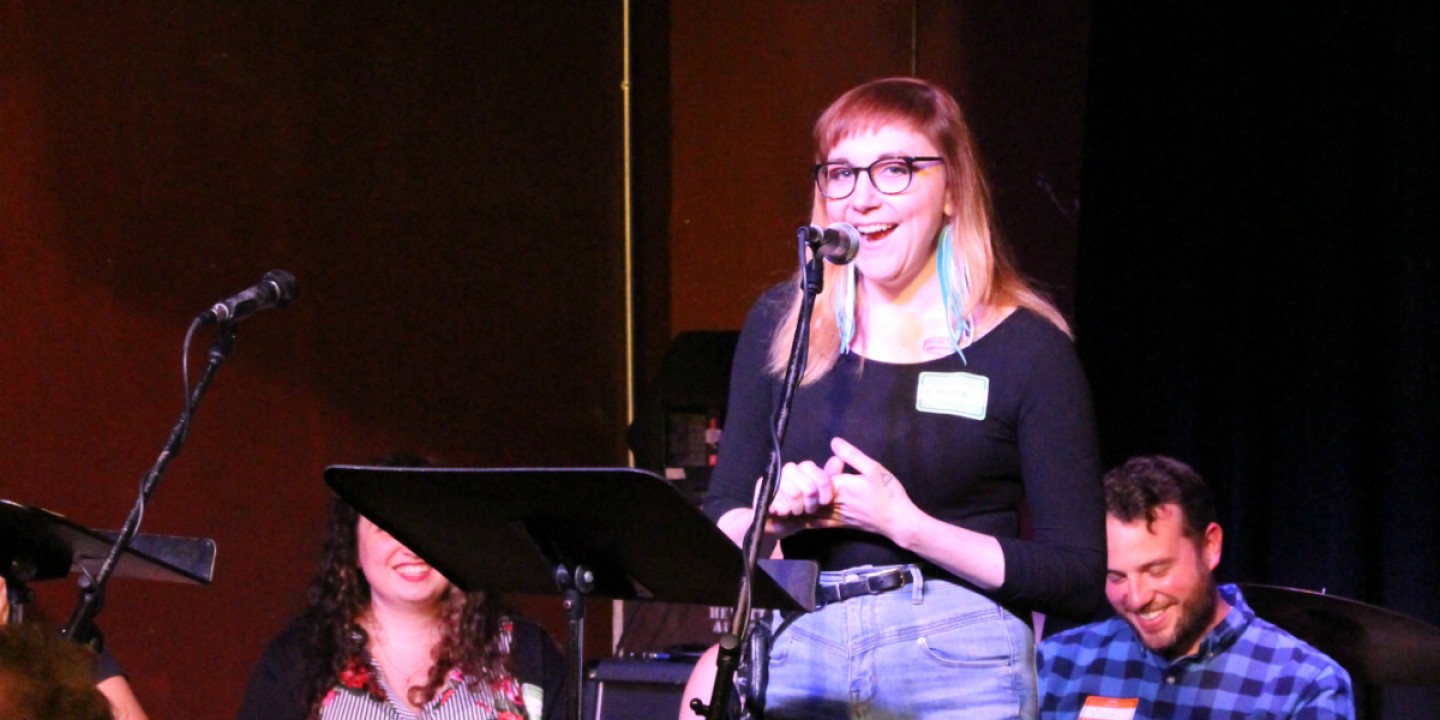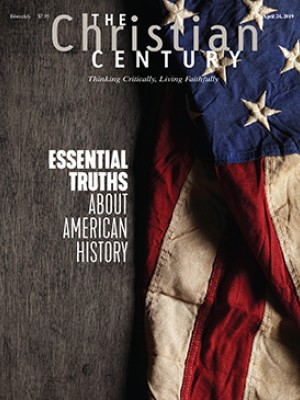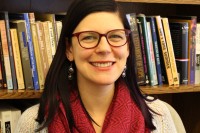At Gilead Church in Chicago, storytelling is central to worship
It's like a MOTH event—with the vulnerability of community.

When Rebecca Anderson attended a Moth storytelling event some ten years ago, she arrived three hours before it was slated to start—and still couldn’t get a seat. “The room was packed with twenty-, thirty-, fortysomethings,” recalled Anderson.
That experience gave the Disciples of Christ pastor an idea. “The evangelist part of me thought, ‘Do we not have a true story to tell in community?’” The former stand-up comic did her booming preacher impression when describing that epiphany. The insight eventually led to Anderson joining with her friend Vince Amlin, a United Church of Christ pastor, in starting a church in which telling stories is central.
Read our latest issue or browse back issues.
Now in its third year, Gilead Church has met in several different venues. In two of them, the worship leaders, storytellers, and preachers have used the performance space of a bar, with the congregation sitting in chairs or on stools at high tables, as though attending a small concert. In the current venue, a disco ball hangs from the ceiling. During communion the celebrants step off the stage to the same level as the congregation. One night at the bar where Gilead met for more than a year, pastors offered the bread and cup to the regular bartender, who received communion at the only rail the church had.
The storytelling often begins after the opening song and welcome. A second story is told later in the service, before the prayers of the people and the sermon. The liturgy is not especially different from that of many UCC or Disciples congregations formed in recent decades. “We haven’t invented anything whole-cloth,” said Amlin.
After each story, the pastor says, “The word of God for the people of God,” and the congregation responds, “Thanks be to God.” Gilead Church believes that everybody’s story is a God story. Amlin sees two parts to that claim: that “every person’s story is holy—no one is excluded from that. But also that every part of each person’s story is a God story.”
A difference between Gilead’s stories and those told at an open mic competition or live event hosted by the Moth is that at Gilead the stories can be a vehicle to create genuine intimacy among people who are getting to know one another. While some storytellers are invited to Gilead after the pastors hear them at a storytelling event, many if not most are part of the congregation. Their storytelling allows for vulnerability, Anderson said, and creates solidarity. It’s one thing to know you are not the only one to have had a miscarriage; it’s another thing to know someone else in the room who had a miscarriage.
Amlin and Anderson have no criteria for what makes a particular story worth sharing in worship. To them, the individual stories and the larger Christian story are connected because of the incarnation.
“God chooses to be present in real life and real bodies,” Amlin said. “That’s why our stories are sacred.”
The worship format underscores the church’s conviction that every life is beloved by God and so is every story, whether—to cite two examples—it’s about taking a pit bull and a pregnant cat to the vet with a van-full of people recovering from addictions or about receiving a confession amid the blaring dance music of the Gay Pride parade.
Amlin likened the work of storytelling to the prayer of examen in Ignatian spirituality, in which people review the events of the day with the aim of becoming more attuned to the movements of God that might otherwise be missed. “In telling and retelling and shaping these stories you can become more aware of God’s presence, both in the past and in the present going forward.”
Susan Haarman, a former campus minister who is part of Gilead’s leadership team, connected the kind of storytelling Gilead does in worship to the element of anamnesis in the Eucharist—it’s about remembering and reliving at the same time.
“By remembering where grace moved in my life, I’m able to channel it and bring it into the room again,” she said, “and extend it to the people who are listening.”
In the recent book Leading by Story: Rethinking Church Leadership, Vaughan S. Roberts and David Sims note that part of the power of stories is that they do not require people to agree with them in order to evoke attention, humility, and openness to being changed.
Describing stories, Anderson cites a claim she’s heard from others: “The universal is in the specific.” More valuable than offering people grand ideas, she said, is talking about one moment or one relationship. Preachers often make statements such as, “You always feel x when y happens,” which only makes listeners think about the gap between the preacher’s experience and their own. Stories bring listeners into the speaker’s experience.
Stories at Gilead might be considered a form of testimony, but Anderson hesitates to use the term because it can sound too formulaic. The classic shape of religious testimony, she says, is “I once was lost and now I am found,” but “there are lots of stories that are ‘I once was lost and I’m still kind of a mess.’”
Gilead has been supported by a onetime grant of $30,000 from Garrett-Evangelical Theological Seminary, one of 12 schools participating in a Lilly Endowment program called the Young Adult Initiative. Gilead is also sustained by donations from the congregation and from the two denominations to which Gilead belongs: the UCC and Disciples.
Gilead Church isn’t for everyone, Anderson and Amlin readily admit. Their hope is that it’s a church for people who have been told or made to feel that the church isn’t for them. The church may jar some people out of their comfort zone, depending on what those comfort zones are. For those who regularly attend storytelling events like the Moth, the setting is familiar, but they may squirm a bit at the religious language. Regular churchgoers will find the words and practices familiar but may be unsure about worshiping in a bar.
Haarman recounted having two kinds of conversations with newcomers. “For folks who either have been out of faith communities for a long time or maybe have felt a lot of pain by faith communities, they walk in and say, ‘This is so radical, this is so different and new,’ which I love. Folks who have been part of Christian communities say, ‘This is church, in a bar, and you swap out some of the scriptures for stories in the themes of the gospel,’ which I also love.”
One unusual aspect of Gilead for those familiar with Christian worship is that scripture is most often told as part of the sermon rather than read beforehand. The pastors’ approach to scripture is to be “as narrative as possible,” Amlin said, “so people who don’t already know these books, these words, can find an entry point.”
Overall the preaching is similar to other mainline preaching except the narrative is more sustained in the sermon. “We try to use narrative not in the spot of sermon illustration or a funny story to get us started but to talk about where the text is for us, in our lives,” Amlin said. “Hopefully it’s doing the work that scripture does.”
In one sermon on a day when the worship theme was “Endings”—and the theme for the month was “Choose your own adventure”—Amlin wove in exegesis with a narrative telling of Jesus appearing to the disciples after the resurrection. By touching Jesus’ wounds, Thomas is seeing that Jesus’ death was not the end. For all of us the challenge is to choose the ending we believe in and want to live toward.
Amlin connected Jesus’ words in John 20:29—“Blessed are those who have not seen and yet have come to believe”—with a story about comforting his three-year-old daughter after she had a bad dream, telling her that he would keep her safe. He chose to tell his daughter that story, he said, “even knowing the ways I’ll fall down in that as a parent and the ways that life hurts us,” he said. “It carries a deeper truth.” The story about his daughter conveyed the sermon’s message that we can choose an ending without certainty about it. “That’s essentially what faith is, choosing a story and choosing to live by that story even in the face of counterinformation.”
Acts of pastoral care can turn out to shape the storytelling. Anderson sometimes follows up with people who have shared an experience privately with her and invites them to tell it in worship. It’s a way of saying the story has value. She recalled hearing a person tell about a cross-country road trip in which the pivotal moment occurred “on the morning of the third day.” The person accepted Anderson’s invitation to tell that story on Easter.
When planning the storytelling part of worship, Gilead’s leaders start with the theme for a worship season or service. Sometimes Anderson will recall someone she heard at a storytelling event who could speak to that topic. On a web page titled “Look, Ma, I’m telling a story at a church!” which Gilead shares especially with the performers, writers, and comics they invite, they emphasize that they don’t ask if storytellers are religious, nor do they ask them to talk about religion. For all storytellers, the parameters for content and language are simply nothing “hateful or disrespectful,” and they specify that they affirm LGBTQ+ folks as they are.
Storytellers sometimes give a content warning, as in the case of one woman who, before talking about her time in the Peace Corps, told listeners that her story involved state-sponsored violence. The pastors have begun acknowledging that the stories may be emotional and stating that they are available to talk afterward. Not many children attend Gilead, and Anderson hasn’t heard about instances of them reacting negatively to content in the stories. Parents have said that if children have questions, they discuss them at home.
Gilead’s pastors think about the church overall as doing the work of translation. They’re striving to make the tradition accessible to people who didn’t grow up with it or who have been pushed out, as well as to a new generation, Amlin said.
Anderson noted that there are things a new church can do that an established church can’t or won’t. “Any congregation is a translation of the gospel,” she said. “A new church is a new translation—not a better translation, but a translation for a specific time and place.”
She recalled being away from church for years and returning as an adult, attending a church plant that was a few years old at the time.
“It wasn’t a new gospel,” she said. “My experience was this Pentecost-y gasp where I heard it. . . . I was, like, ‘Oh, I understand what they’re saying.’”
A version of this article appears in the print edition under the title “Every story is a God story.”







